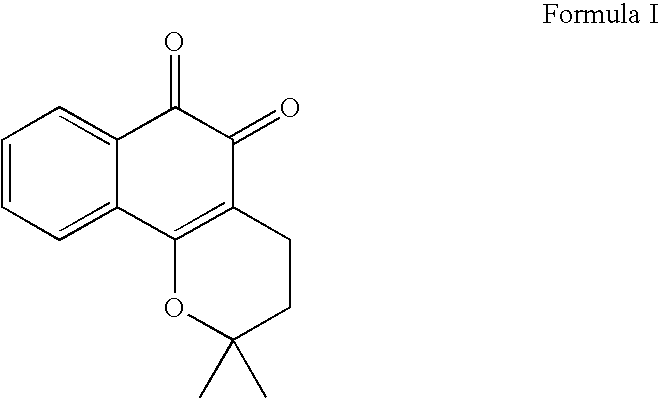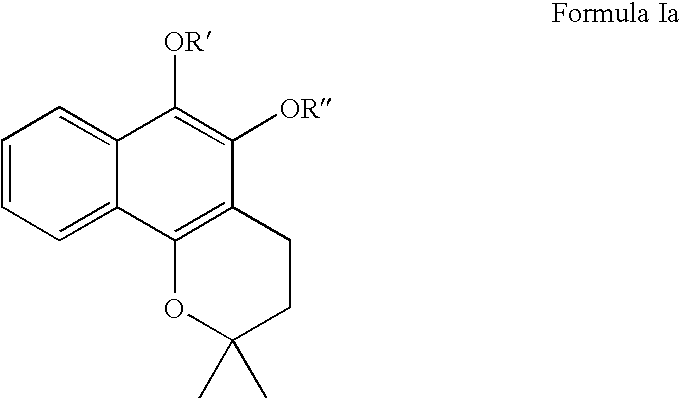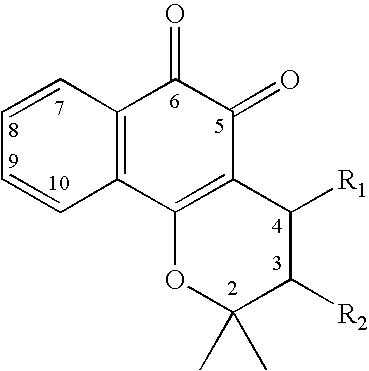Compositions for modulation of PARP and methods for screening for same
a technology of parp and modulation, applied in the field of compositions for modulation of parp and methods for screening for same, can solve the problems of cell death by necrosis, cell death by apoptosis, and depletion of nad+/atp, and achieve the effect of increasing the synthesis of poly(adp ribose)
- Summary
- Abstract
- Description
- Claims
- Application Information
AI Technical Summary
Benefits of technology
Problems solved by technology
Method used
Image
Examples
example 1
PARP Screening
1. Cell Death Assays
[0127] Cell death was determined by the 3-(4,5-dimethylthiazol-2-yl)-2,5-diphenyl tetrazolium bromide (MTT) assay or by trypan blue exclusion, as indicated. Briefly, HeLa and DLD1 cells were plated in a 96-well plate at 10,000 cells per well, cultured for 24 h in complete growth medium, then treated with various concentrations of β-lapachone for 4 h MTT was added to a final concentration of 0.5 mg / ml, and incubated for 1 hr, followed by assessment of cell viability using a microplate reader at 570 nm.
[0128] For the trypan blue exclusion assay, HeLa and DLD1 cells were plated in 6-well plate and treated in the same way. They were harvested, and trypan blue dye solution was added to the cell suspension. Total cell counts and viable cell numbers were determined with a hemacytometer. For the PARP inhibition study, cells were pre-teated for 1 h with the PARP inhibitor 3-aminobenzamide (3-AB, 5 mM), and then co-treated with inhibitor and β-lapachone f...
example 2
β-Lapachone Induction of Cell Death is Inhibited by the PARP Inhibitor 3-Aminobenzamide
[0135] MTT assays showed that β-lapachone-induced cell death is blocked by PARP inhibitor 3-aminobenzamide (3-AB). HeLa and DLD1 cells were plated in 96-well plates at 10,000 cells per well, cultured for 24 h in complete growth medium, pretreated with PARP inhibitor 3-AB (SM) or equal volume of DMSO for 1 h, and then exposed to β-lapachone at various concentrations for a further 4 h, followed by MTT assay.
[0136] As shown in FIG. 1, HeLa cell survival percentage rises from approximately 5% to 60% in HeLa cells, and to approximately 75% in DLD1 cells.
[0137] Similar results were shown using Trypan Blue staining in HeLa cells (FIG. 2) and DLD1 cells (FIG. 3).
example 3
β-Lapachone Induces Rapid Cellular Activation of PARP, which is Blocked by 3-Aminobenzamide
[0138]β-lapachone induces rapid activation of PARP in HeLa cells. HeLa cells were grown on coverslips for 24 h, then treated with 4 μM β-lapachone at different time points and fixed with methanol acetone (70 / 30, v / v) for 10 min. Samples were incubated in blocking buffer (5% FBS in PBS) for 10 minutes at room temperature in a humid chamber. Cells were incubated overnight at 4° C. with monoclonal anti-poly(ADP-ribose) antibody (10H 1:100). After washing, the cells were incubated for 1 h at room temperature with FITC conjugated anti-mouse antibody (1:1,000). Immunofluorescence was evaluated using an immunofluorescence microscope equipped with a CCD camera.
[0139] As shown in FIG. 4, β-lapachone increases fluorescence due to the presence of monoclonal anti-poly(ADP-ribose) antibody bound to the product of PARP, showing a β-lapachone induced activation of PARP.
[0140]β-lapachone induced activation...
PUM
| Property | Measurement | Unit |
|---|---|---|
| molecular mass | aaaaa | aaaaa |
| concentration | aaaaa | aaaaa |
| temperature | aaaaa | aaaaa |
Abstract
Description
Claims
Application Information
 Login to View More
Login to View More - R&D
- Intellectual Property
- Life Sciences
- Materials
- Tech Scout
- Unparalleled Data Quality
- Higher Quality Content
- 60% Fewer Hallucinations
Browse by: Latest US Patents, China's latest patents, Technical Efficacy Thesaurus, Application Domain, Technology Topic, Popular Technical Reports.
© 2025 PatSnap. All rights reserved.Legal|Privacy policy|Modern Slavery Act Transparency Statement|Sitemap|About US| Contact US: help@patsnap.com



